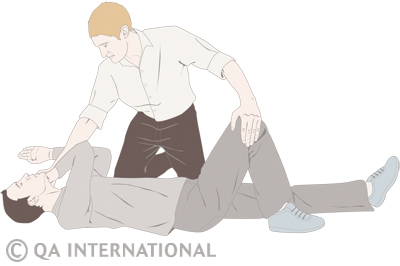
Emergency first aid: reflexes that can save lives
Knowing the first steps to follow in an emergency often helps to prevent the worst outcome and can provide the time required to obtain professional medical assistance.
What to do
1. Remain calm and quickly analyze the situation. Reduce the risk of aggravation by securing the premises (cut electrical power, stop cars, etc.). Avoid placing yourself in danger or hurting yourself.
2. Call for emergency assistance, indicate your location, the state of the victim, and the cause of the accident.
3. If the victim is conscious
A. Name yourself and reassure the victim. If they suffered a trauma, ask them not to move. Control all excessive bleeding.
B. Disengage or clear the airways, if needed.
C. While waiting for assistance, monitor the victim's state of consciousness, breathing, and pulse, and establish their assessment: (SAMDLE) :
- Signs and symptoms: How does the victim feel? In the event of malaise, what were the signs before the current situation?
- Allergies: Does the victim have allergies?
- Medications: Does the victim take any medication? If so, which one(s)? If they take medication for the problem that is affecting them at that moment, help them take it according to the dose.
- Diseases: Does the victim have known medical issues? Do they have a medical bracelet?
- Last meal: What was the last meal consumed by the victim and when?
- Event: How did the accident occur?
4. If the victim is semiconscious or unconscious, assess their state of breathing.
A. If they are breathing, place them in the recovery position.
B. If they are not breathing, conduct cardiopulmonary resuscitation.
C. Assess the state of the victim's blood circulation while controlling serious bleeding.
5. Examine the victim from head to toe to detect injuries and give necessary first aid (wound dressing, immobilization of fractures, etc.).
Regularly monitor vital signs (breathing, pulse) until assistance arrives.
How to assess a victim’s state of consciousness
A person is unconscious if they do not open their eyes when asked to or when their skin is pinched, or if they do not respond to any questions. A person who gives incoherent or incomprehensible responses may be partially conscious. In an emergency situation, the state of consciousness may change and must be verified regularly.
How to assess breathing
To verify if someone is breathing, first be sure that their airways are clear. Lay your cheek close to the nose and mouth of the victim, turning your face towards their chest. Try to make out breathing, listen for noises caused by breathing, and observe their chest to see if it rises by placing your hand on it. Count the number of rises for 15 seconds and multiply the number by 4 to know the number of breaths per minute. In adults, a rate below 10 breaths per minute or more than 24 breaths per minute requires examination by specialized medical personnel. A respiratory problem can manifest itself by breathing that is loud, too slow, too fast, superficial (panting), deep, or irregular. Blue coloring of the skin is a sign of respiratory deficiency.
Warning! If the victim is unconscious, is not breathing, and does not have any thoracic wounds, cardiopulmonary resuscitation must be performed quickly and emergency responders must be notified that a defibrillator may be needed.
| Age | Frequency (breaths per minute) |
|---|---|
| Under than 1 year | 30 to 50 |
| 1 to 8 years old | 20 to 30 |
| Over 8 years old | 12 to 20 |
How to take a pulse
The radial pulse is taken by placing your index and middle fingers on the inside of the wrist, on the side of the thumb. The carotid pulse is taken on the neck with two or three fingers. The fingers are placed on the Adam’s apple, then progressively slid to the side to a dip located between the Adam’s apple and neck muscles, where slight pressure is exerted. Then, the number of pulsations are counted for 30 seconds and the result is multiplied by 2. In the event of cardiopulmonary arrest, circulation must be reestablished immediately. Since taking a pulse delays medical intervention, it is recommended to conduct cardiopulmonary resuscitation as soon as unconsciousness and absence of breathing are established.
| Age | Frequency (beats per minute) |
|---|---|
| Under than 1 year | 100 to 140 |
| 1 to 8 years old | 80 to 100 |
| Over 8 years old | 50 to 100 |
Radial pulse

Carotidien pulse

Recovery position
If the injuries allow it, a semiconscious or unconscious victim must be placed in the recovery position to keep airways open and to prevent choking.
1. Placement
Get into position next to the victim who is lying down. Place the arm closest to you perpendicular to the body. Fold the other arm to place the back of the hand on the cheek. Lift the knee that is further away.

2. Roll
Roll the victim towards you by pulling on the folded knee; protect the head while proceeding with the rotation. Adjust the head back and block it in extension, resting it on the hand you placed against the cheek. Position the arms and legs in a way to stabilize the body. Cover the victim.

Also see:
In the Visual Dictionary:
- "human being" section
- "health" section
In the encyclopedic capsules :
- First aid materials and services
- Hygiene and the prevention of infections
- Travel health - prevention over cure
- The flu - a virus that produces fever
In the ikonet games:
- Put it in its place!:




